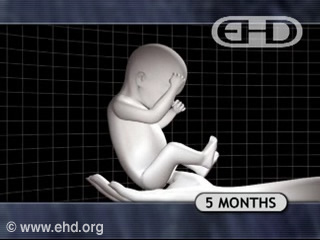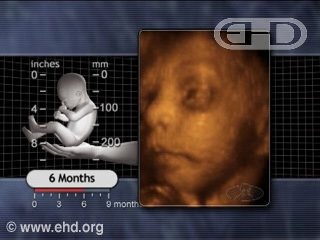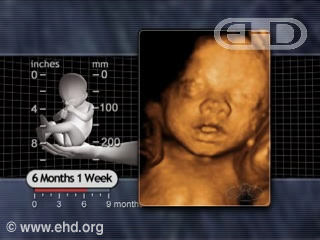Prenatal Form and Function – The Making of an Earth Suit
Unit 15: 5 to 6 Months (20 to 24 Weeks)
 Closer Look:
Closer Look:
 Applying the Science:
Applying the Science:

Copyright © 2006 EHD, Inc. All rights reserved.
In the growing fetus, the 2 sides of the brain begin to differentiate asymmetrically as early as 20 weeks.1
The structure of the fetal gastrointestinal tract has developed to approximate that of the newborn although full function is still weeks away.2
Rapid eye movement, or REM, a term describing the distinct pattern of eye motions seen during the stage of sleep where dreaming occurs,3 begins between 18 and 21 weeks.4

By 24 weeks, the eyelids reopen5 and the fetus exhibits a blink-startle response.6 This reaction to sudden, loud noises typically develops earlier in the female fetus.7 This response is very much like what adults and children exhibit in the same situation.
When exposed to a loud noise, the fetal heart rate increases, as does the rate of movement.8 Excessive fetal swallowing following exposure to loud noise may lead to a loss of amniotic fluid.9 Possible long-term consequences for fetuses are the same as consequences for children and adults: hearing loss and deafness.10
The fetus also responds to pressure, movement, pain, hot and cold, taste, and light.11
The fetus makes breathing motions about 14 percent of the time, drawing amniotic fluid inside the lungs.12 The fetal respiratory rate can rise as high as 44 inhale/exhale cycles per minute at 22 to 26 weeks.13 This rate changes according to maternal carbon dioxide (CO2) levels, strongly suggesting that the respiratory center in the brainstem of the fetus already detects and responds to changes in CO2 levels in the blood. This respiratory response to CO2 levels is similar to that seen in newborns and adults.14
| 1 | Weinberger et al., 1982. 97. |
| 2 | Lebenthal et al., 1983. 1. |
| 3 | Vitaterna et al., 2001. 92. |
| 4 | Okai et al., 1992. 392. |
| 5 | Andersen et al., 1967. 293; Campbell, 2002. 3; O'Rahilly and Müller, 2001. 465. |
| 6 | Birnholz and Benacerraf, 1983. 517; Campbell, 2002. 3; Drife, 1985. 778. |
| 7 | Lecanuet and Schaal, 1996. 9. |
| 8 | Visser et al., 1989. 285. |
| 9 | Petrikovsky et al., 1993. 548-549. |
| 10 | Gerhardt, 1990. 299; Pierson, 1996. 21, 26; Petrikovsky et al., 1993. 548-549. |
| 11 | Mancia, 1981. 352. |
| 12 | Davis ME and Potter E, 1946. 1199. |
| 13 | Natale et al., 1988. 317. |
| 14 | Connors et al., 1989. 932. |





